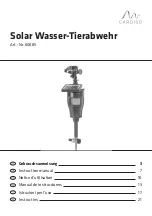
Introduction
Operating instructions RHF
19
ELTROPLAN
-
REVCON
Elektrotechnische Anlagen GmbH
3.4 Harmonic Mitigation
To mitigate the harmonics caused by the frequency converter 6-pulse rectifier
several solutions exist and they all have their advantages and disadvantages. The
choice of the right solution depends on several factors:
•
The grid (background distortion, mains unbalance, resonance and type of
supply – transformer / generator)
•
Application (load profile, number of loads and load size)
•
Local / national requirements/regulations (IEEE519, IEC, G5/4, etc.)
•
Total cost of ownership (initial cost, efficiency, maintenance, etc.)
IEC standards are harmonized by various countries or supranational organiza-
tions. All above mentioned IEC standards are harmonized in the European Union
with the prefix “EN”.
For example the European EN 61000-3-2 is the same as IEC 61000-3-2. The situ-
ation is similar in Australia and New Zealand, with the prefixes AS/NZS.
Harmonic solutions can be divided into two main categories: Passive and active
were the passive solutions consist of capacitors, inductors or a combination of
the two in different arrangements.
The simplest solution is to add inductors/reactors of typically 3% to 5% in front of
the frequency converter. This added inductance reduces the amount of harmonic
currents produced by the drive.
More advanced passive solutions combine capacitors and inductors in trap ar-
rangement specially tuned to eliminate harmonics starting from e.g. the 5th har-
monic.
















































